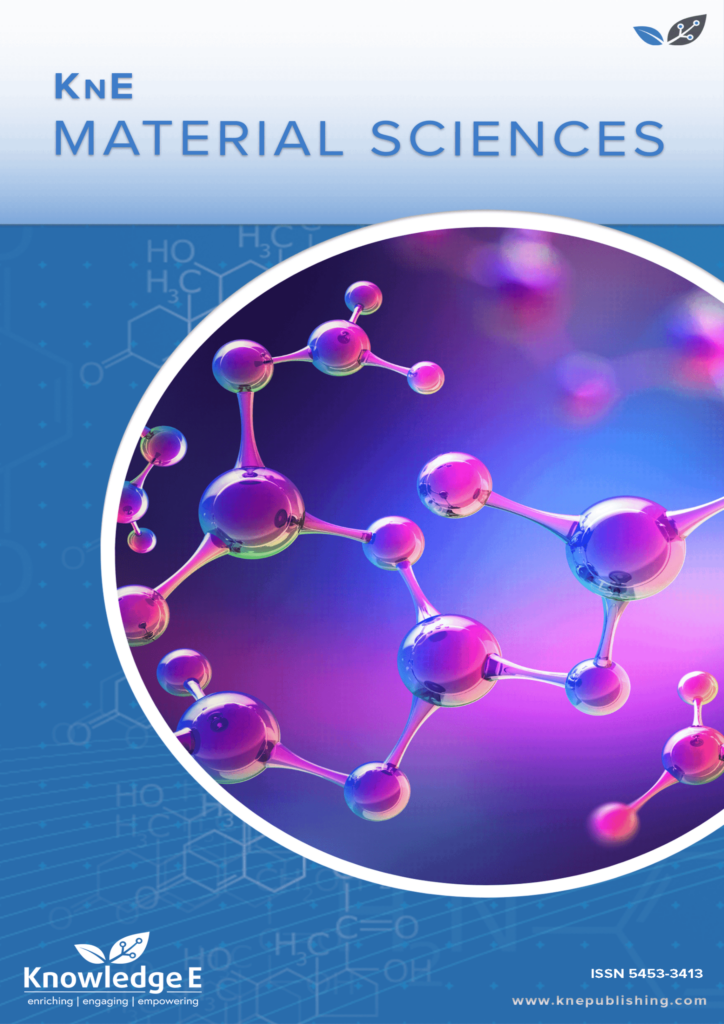
KnE Materials Science
ISSN: 2519-1438
The latest conference proceedings on physical materials, energy materials, electrical materials.
Agrimonia Eupatoria L.-Incorporated Electrospun Nanofibers and Cotton Composite for Antibacterial Wound Dressing Applications
Published date: Aug 10 2022
Journal Title: KnE Materials Science
Issue title: 1st International FibEnTech Congress (FibEnTech21) – New Opportunities for Fibrous Materials in the Ecological Transition
Pages: 46–53
Authors:
Abstract:
Composite wound dressings which combine the suitable properties of distinct materials into one dressing are currently being explored, in combination with different types of bioactive compounds, to enhance the healing process and avoid skin infections. In the present work, poly(vinyl alcohol) and chitosan nanofibers containing Agrimonia eupatoria L. were fabricated using a needleless electrospinning method (through Nanospider technology) and deposited on top of a 2,2,6,6-tetramethylpiperidine-1-oxyl (TEMPO)-oxidized cotton textile dressing. The negatively charged carboxyl groups on the cotton fibers interacted with the positively charged amino groups of chitosan, which was previously blended with poly(vinyl alcohol) and Agrimonia eupatoria L. to produce the nanofiber layer. The properties of the produced composite materials were analyzed to determine the dressing’s potential for antimicrobial wound dressing applications.
Keywords: cotton, textile dressing, electrospun nanofibers, Agrimonia eupatoria L., antibacterial composite wound dressings
References:
[1] Adamu BF, Gao J, Jhatial AK, Kumelachew DM. A review of medicinal plant-based bioactive electrospun nano fibrous wound dressings. Materials & Design. 2021;209:1- 9. https://doi.org/10.1016/j.matdes.2021.109942
[2] Simões D, Miguel SP, Ribeiro MP, Coutinho P, Mendonça AG, Correia IJ. Recent advances on antimicrobial wound dressing: A review. European Journal of Pharmaceutics and Biopharmaceutics. 2018;127:130–141. https://doi.org/10.1016/j.ejpb.2018.02.022
[3] Pinho E, Soares G. Functionalization of cotton cellulose for improved wound healing. Journal of Materials Chemistry. 2018;6:1887-1898. https://doi.org/10.1039/c8tb00052b
[4] Wang F, Hu S, Jia Q, Zhang L. Advances in electrospinning of natural biomaterials for wound dressing. Journal of Nanomaterials. 2020;2020:1-14. https://doi.org/10.1155/2020/8719859
[5] Nikolic T, Korica M, Milanovic J, Kramar A, Petronijevic Z, Kostic M. TEMPOoxidized cotton as a substrate for trypsin immobilization: impact of functional groups on proteolytic activity and stability. Cellulose. 2017;24:1863-1875. https://doi.org/10.1007/s10570-017-1221-1
[6] Gomes AP, Mano JF, Queiroz JA, Gouveia IC. New biomaterial based on cotton with incorporated biomolecules. Journal of Applied Polymer Science. 2014;131:1-9. https://doi.org/10.1002/app.40519
[7] Mouro C, Gomes AP, Ahonen M, Fangueiro R, Gouveia IC. Chelidonium majus L. Incorporated emulsion electrospun PCL/PVA_PEC nanofibrous meshes for antibacterial wound dressing applications. Nanomaterials. 2021;11:1-17. https://doi.org/10.3390/nano11071785
[8] Bombin ADJ, Dunne NJ, McCarthy HO. Electrospinning of natural polymers for the production of nanofibres for wound healing applications. Materials Science and Engineering. 2020;114:1-14. https://doi.org/10.1016/j.msec.2020.110994